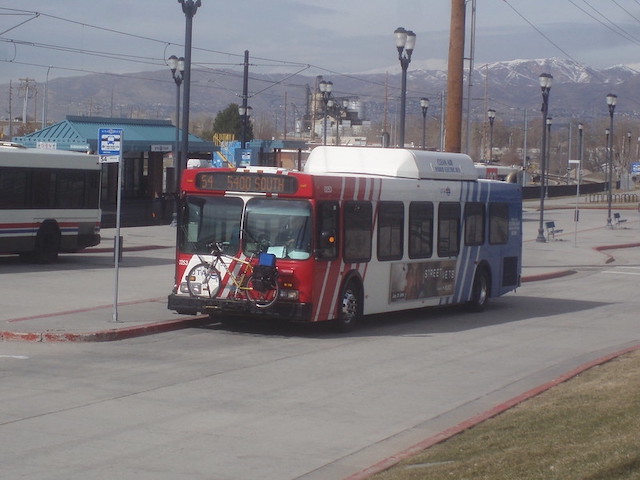Bloomberg reports that, when Utah Transit (UTA) eliminated transit fares on a trial basis in February, weekday ridership grew by 16 percent. Overall, the latest data show, average daily ridership was only 18 percent greater than it had been in January. That compares with 25 percent for the nation’s transit systems as a whole, suggesting that free transit may not have been the reason why ridership increased.
Utah Transit buses have an average of 36 seats but carried an average of just 5 passengers (that is, they carried 5.0 passenger-miles per vehicle mile) in 2019 and just 3.6 in 2020. Photo by Paul Kimo McGregor.
Considering that passenger fares brought more than $48 million into UTA’s budget in 2019, such a small boost in ridership hardly seems worth the loss of that revenue. Transit agencies, however, desperately need reasons to justify their heavily-subsidized existence. Offering free fares may boost ridership, if only by a small amount, but more important it insulates agencies from ridership fluctuations. If the agencies are solely dependent on taxpayers to keep their buses and trains running, then all they have to do is convince taxpayers or appropriators that transit is somehow vital to cities even if hardly anyone uses it.
Bloomberg’s writer, David Zipper, buys into the erroneous claim that free transit is good for social equity when the truth is that transit subsidies are disproportionately paid by low-income people who don’t ride transit. But at least he doesn’t buy into claims that free transit is good for reducing greenhouse gas emissions. In 2019, Utah Transit buses emitted twice as much greenhouse gases per passenger-mile as the average light truck and in 2020 it was almost three times as much.
But that’s not why Zipper says free transit isn’t good for reducing emissions. Instead, he points to studies showing that even if free transit boosts ridership, it doesn’t reduce driving. The reason is that the main people who are attracted to free transit are low-income people who don’t have cars, so giving them transit rides doesn’t cut down on driving.
“There’s no evidence at all that cities introducing fare-free public transport have seen their car traffic reduced,” the CEO of the International Association of Public Transport told Zipper. That organization’s study of free public transit found that, “most of the [new] people taking [free] public transport used to walk.”
As I’ve said many times before, people who want to increase transportation equity give more low-income people access to cars. People who want to reduce greenhouse gas emissions should encourage people to drive more fuel-efficient cars. Outside of New York City, transit is insignificant as a form of transportation, but reducing subsidies to transit would probably result in a net decrease in both inequity and greenhouse gas emissions. Unfortunately, people are using climate change and income inequality to try to socially engineer American cities, and that always proves an expensive failure.









The common perception of transit by those who don’t use it is it’s a cheap, crappy, inadequate service. If they Charge nothing for the service; what it advertises is that it ain’t worth anything or a particular value.
Local agencies have been offering “Free Fares”for a while now, with some moderate or piss poor success. What fares do is two things…
1) indicate sense of willing value trade for wanting to use service. Nationally, more than 20% of public school teachers with school-age children enroll them in private schools, Twice national average. In any case, the public employees’ willingness to pay full price or a sizeable chunk of their salary; for a competing product or service and forgo their employer’s product or service at a reduced price (or no cost) makes a strong statement about the low quality of said service. For years; California has wrote bills to Repeal farebox recovery ratio mandates for it’s commuter rail and various transit schemes. If California has no faith their trains can make sufficient revenue… Why build HSR they claim will be “Economical”
2) Fares assure greater safety, because fare enforcement or even understanding fares, Honest people pay.
bear in mind, the criminal class, often always jump fare collections. India is it’s greatest example; fare evasion is ubuiquitous, as is… theft, sexual assault and rampant infrastructure vandalism.
Real question is “Why are they trying to give it away for free? If they cant even operate a system people are willing to pay for with modest fee that’s supposedly more economical than automobiles. 16% gain is 1/6, as most transit systems have lost Anywhere from half to 80% of their ridership…..
What about an increase in crime when no fare is collected? Apparently on BART in the SF bay area 80% of criminals on BART didn’t pay the fare. See:
https://www.mercurynews.com/2022/01/05/roadshow-why-wont-bart-fix-its-gates-to-target-fare-cheaters/
https://www.ktvu.com/news/violent-crime-soars-on-bart-fare-evasion-costs-25m-a-year-grand-jury-report
https://www.independent.org/publications/article.asp?id=13843
Some years ago I attended a community support group for drug addicts. Apparently, they rode around on BART because they didn’t have to pay, committing crimes in the neighborhoods near stations, sleeping on the trains, etc. If transit is free, will this be the type of person who rides transit?
Great move by transit agencies to deal with complaints.
If you’re getting it for free, you’ve got nothing to complain about.